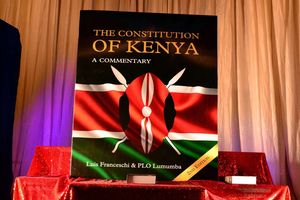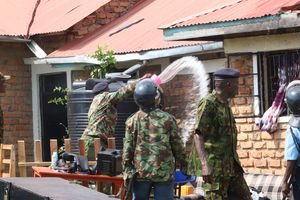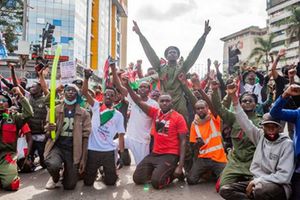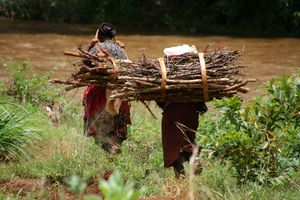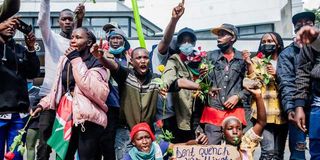
Protesters picketing along Kimathi Street in Nairobi during the commemoration of the Gen-Z protests on June 2, 2025.
Kenya is now firmly mired in a low-intensity civil war, exiting the category of Africa’s most politically stable and economically successful countries and entering the limbo of countries of interest for the African Union’s “Silencing the Guns” initiative.
The July 3, 2025 issue of The Economist carried a damning headline: “William Ruto is taking Kenya to a dangerous place.” The influential Magazine argued that the “president's authoritarian instincts are propelling a spiral of violence,” calling on him to change tact. In changing tact, the government must cease its unrelenting assault on the principle of popular sovereignty, the single most critical issue that has plunged the country into a low-intensity civil war with its youth population.
The principle of popular sovereignty, critical in the Constitution, maintains that the authority of a state and its government “are created and sustained by the consent of its people” as the sole source of all power and political legitimacy. Inversely put, power does not come from the figment or a messianic complex where one citizen deludes themselves that they are responsible for saving others.
Kenya’s low-intensity civil war may not be in the same league as the Ethiopian civil war in Tigray (2020-2022) that left an estimated 600,000 people dead; the current Sudanese civil war (April 2023-present) with an estimated death toll of over 150,000; or even the more protracted Congolese Civil War (1996-present), which has killed six million people.
Experts define a low-intensity civil war as “a protracted political-military conflict within a nation” where the degree of violence and the extent of resources deployed are relatively limited compared to a full-scale civil war. While a low-intensity civil war is about the struggle for political control, legitimacy, and resources, it involves irregular warfare, insurgencies, and counterinsurgency operations.
New political order
The battle lines are marked with stormtroopers of a new political order being the youth who stormed Parliament last year. Their protests have seen police stations, government buildings and vehicles burning down, widespread looting, barriers erected on roads, the shutdown of government operations and making some spaces ungovernable.
As its “counterinsurgency operations,” the government has issued “shoot-to-kill” orders, shot protesters, killed and abducted Gen-Z activists, protected goons during protests and introduced the Public Order Amendment Bill, 2025 to limit demonstrations.
Murang’a County and the country mourn Boniface Mwangi Kariuki, a 22-year-old street hawker, who sold face masks before the police shot him during the June 17 protests in Nairobi. Kariuki died on June 30, 2025, from severe head injuries. His family is further burdened with a bill of Sh3.6 million at Kenyatta National Hospital. As the family lay Kariuki to rest at Nderi village, Kangema on July 11, 2025, their cry for justice must be heeded.
He was victim of Kenya’s low-intensity war. He joins a growing tally of over 90 youth killed in protests— 63 during the 2024 Gen-Z uprisings, 19 during demos in Nairobi on June 17 against police brutality after Albert Ojwang murder, and eight during the June 25 Gen Z anniversary demonstrations.
Kenya’s youth problem is self-inflicted. The causes of the war are the hubris of power, misplaced priorities, corruption and cronyism by power elite. Over the 2013-2025 hiatus, the leadership fiddled as Rome burned, failing to prevent the youth from becoming a security threat and turning it into an economic boon.
As the Jubilee government of Uhuru Kenyatta and William Ruto came to power in 2013, the youth boom was already becoming a ticking time bomb. The population of those aged 15-35 had reached an all-time high of 35.75 per cent by 2015 and is projected to stand at 34.90 per cent by 2030 or 18,036,281 people. Both Vision 2030 and the National Youth Vision called on the leadership to invest in the youth to create “a dynamic and empowered youth in leadership and entrepreneurship for a globally competitive and prosperous Kenya.”
Investment in technology and industrialisation to create skills, jobs and opportunities was the agenda after the first Second Medium Term Plan (2008-2013) implemented by President Mwai Kibaki. But the subsequent Medium Term Plans were mere populist and rhetorical lip-service to the youth agenda.
Jubilee Coalition's Second Medium Term Plan (2013-2017) promised jobs, commercialized agriculture, and improved manufacturing. However, it offered a long laundry list of everything under the sun: devolution, economic growth, social development. Eventually, the youth agenda was drowned in the ensuing turf-wars an orgy of corruption to create war-chests for the 2022 succession.
Big Four Agenda
Realizing that 2013-2017 was a lost half-decade, Kenyatta cobbled together the “Big Four Agenda” as part of the Third Medium Term Plan (MTP III) (2018-2022). The manufacturing pillar was laudable response to the youth as a time bomb. But the others, compared to boosting technology and industrialisation, could not enhance youth access to local, regional and global markets and opportunities.
Besides its populist hue, President Ruto’s “Bottom-up” economic plan, implemented through the Fourth Medium Term Plan (2022-2027), promised everything and nothing at the same time, including agriculture, MSMEs, housing, healthcare, and the digital economy. Hardly one year into office, his ‘tax-to-prosperity’ formula fuelled the high cost of living, hunger, unemployment, and low tax revenue collection, which the Bottom-up plan was created to cure. It also ignited opposition-led protests from January 2023, and brought the kids into the streets in 2024.
As a response to the youth crisis, the “broad-based government” is as absurd as a square peg in a round hole. The mongrel model missed the point as the Gen-Z revolt is not about parties and tribes; it is about a new moral order and fiscal discipline to create wealth.
Part of Agenda 2063 of AU’s “Silencing the Guns” initiative should focus on Kenya.
Professor Peter Kagwanja is the Chief Executive of the Africa Policy Institute and former Government Adviser.

